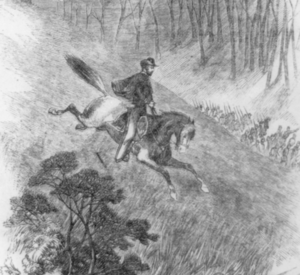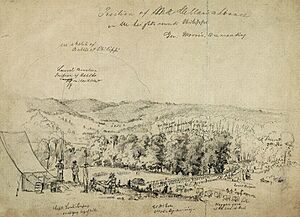Battle of Philippi (1861) facts for kids
Quick facts for kids Battle of Philippi |
|||||||
|---|---|---|---|---|---|---|---|
| Part of the American Civil War | |||||||
 Daring ride on horseback of Col. Frederick W. Lander, June 3, 1861 |
|||||||
|
|||||||
| Belligerents | |||||||
| Commanders and leaders | |||||||
| Units involved | |||||||
| 1st West Virginia Infantry 2nd West Virginia Infantry (reserve) 6th Indiana Infantry 7th Indiana Infantry 9th Indiana Infantry 14th Ohio Infantry |
9th Virginia Infantry Battalion 25th Virginia Infantry 31st Virginia Infantry 11th Virginia Cavalry 14th Virginia Cavalry |
||||||
| Strength | |||||||
| 3,000 | 800 | ||||||
| Casualties and losses | |||||||
| 4 killed or wounded | 26 killed or wounded | ||||||
The Battle of Philippi was an early fight in the American Civil War. It happened on June 3, 1861, in Philippi, Virginia. This area is now West Virginia. The Union side won this battle. Many people saw it as a small fight, not a major battle.
However, newspapers in the North called it a huge win. This encouraged leaders to push for a quick attack on the Confederate capital, Richmond. That attack later led to a Union loss at the First Battle of Bull Run. The battle also made George B. McClellan famous. It was also notable for the first battlefield amputations.
The Battle of Philippi was one of the first Union victories in western Virginia. It helped the Union government in the area. This government later created the new state of West Virginia. Because the Confederate soldiers ran away quickly, the Union side jokingly called the event the "Philippi Races."
Contents
Why Did the Battle of Philippi Happen?
After the war started at Fort Sumter in April 1861, George B. McClellan joined the Union Army. On May 13, he took command of the Department of the Ohio. This department was based in Cincinnati, Ohio. McClellan planned to attack what is now West Virginia. He hoped this would lead to a campaign against the Confederate capital in Richmond.
His main goals were to protect Union supporters in the area. He also wanted to keep the Baltimore & Ohio Railroad open. This railroad was a very important supply line for the Union.
On May 26, McClellan learned that bridges on the Baltimore & Ohio Railroad were burned. He ordered Benjamin Franklin Kelley, a Union colonel, to move his troops. Kelley's 1st West Virginia Infantry was to secure a bridge at Fairmont. This town was about 70 miles (113 km) southeast of Wheeling.
Kelley's men were joined by the 16th Ohio Infantry. After securing Fairmont, the 1st West Virginia moved on. They captured Grafton, an important railroad junction. Grafton was about 15 miles (24 km) southeast of Fairmont.
Meanwhile, the 14th Ohio Infantry was ordered to Parkersburg. From there, they went to Grafton, about 90 miles (145 km) east. By May 28, McClellan had sent about 3,000 troops into western Virginia. He put them all under the command of Thomas A. Morris.
On May 4, Confederate Colonel George A. Porterfield was put in charge of state forces in northwestern Virginia. He was ordered to Grafton to recruit soldiers. As Union troops advanced, Porterfield's 800 poorly armed recruits retreated. They went to Philippi, about 17 miles (27 km) south of Grafton.
Philippi was the main town of Barbour County. This county had voted to leave the Union. A Confederate flag had been flying over the courthouse since January 1861. In Philippi, a covered bridge crossed the Tygart Valley River. This bridge was a key part of the important Beverly-Fairmont Turnpike.
Porterfield's troops were not yet fully organized. They were made up of local recruits from several counties. These groups eventually became parts of the 25th Virginia Infantry, the 31st Virginia Infantry, the 11th Virginia Cavalry, and the 14th Virginia Cavalry.
How the Battle Unfolded
Colonel Kelley planned a two-part attack on the Confederate forces in Philippi. General Morris approved this plan on June 1. The main attack would be 1,600 men led by Kelley himself. They would pretend to go towards Harpers Ferry. They left by train to the east.
They got off the train at Thornton. Then they marched south on a back road. They aimed to arrive at the back of Philippi.
Meanwhile, the 7th Indiana was sent to Webster. This was about 3.5 miles (5.6 km) southwest of Grafton. They would meet with the 6th Indiana and the 14th Ohio. This group of 1,400 men was led by Ebenezer Dumont. They would march directly south from Webster on the Turnpike. This plan was a double attack to surround the Confederates.
On June 2, the Union groups began their march to Philippi. They marched all night in the rain. Both groups arrived at Philippi before dawn on June 3. Morris had planned a surprise attack before sunrise. A pistol shot would signal the start.
The Confederate soldiers were new and had not set up guards. They stayed in their tents to escape the cold rain. A Confederate supporter, Mrs. Thomas Humphreys, saw the Union troops coming. She sent her young son on horseback to warn the Confederates. Union guards captured her son. Mrs. Humphreys then fired her pistol at them. She missed, but her shots started the attack too early.
The Union soldiers began firing their cannons. This woke up the Confederates. Those who had weapons fired a few shots. Then, the Southerners ran away to the south. Some were still in their pajamas. This is why Union journalists called it the "Races at Philippi."
Dumont's soldiers entered the town from the bridge. Colonel Frederick W. Lander rode down a steep hill. His daring ride was later shown in Leslie's Weekly magazine. Kelley's group, however, arrived from the north on the wrong road. They could not block the Confederate retreat. Kelley himself was shot while chasing some Confederates. But Colonel Lander chased and captured the man who shot Kelley. The Confederates retreated to Huttonsville, about 45 miles (72 km) south.
What Happened After the Battle?
The Battle of Philippi was the first organized land fight of the war. The Union victory, though small, made McClellan famous. Northern newspapers made it seem like a huge win. This made politicians demand a big attack on Richmond, which led to the Battle of Bull Run.
The people of Philippi were the first in western Virginia to feel the effects of the war. Most people in the town supported the Confederacy. Many had fled south with their belongings. They were afraid of the Union advance. A month after the battle, it was reported that Philippi was almost empty. Only three families had returned.
A newspaper writer from the Cincinnati Times wrote about the town. He said many houses were damaged. Most were empty because people had fled. He noted it was a strong Confederate town. Even the women still supported the Confederacy.
A record book of soldier misdeeds was found. It showed soldiers breaking into houses and stealing. Many men from Philippi had left before or after the battle. Some did not return until after the war. This left the women to care for their families and property.
There were two important Confederate casualties. Both had amputations on the battlefield. These were believed to be the first such operations of the war. One was a cadet named Fauntleroy Daingerfield. The other was James E. Hanger, an 18-year-old college student.
After recovering, Hanger returned home. He made an artificial leg from barrel parts. It had a hinge at the knee. His design worked very well. The Virginia State Legislature asked him to make these "Hanger Limbs" for other wounded soldiers. After the war, Hanger patented his invention. He started a company that is now Hanger Orthopedic Group, Inc. As of 2007, it was a top maker of artificial limbs in the United States.
After the battle, Colonel Porterfield was replaced. Robert S. Garnett took command of Confederate forces in western Virginia.
Ambrose Bierce was a writer and satirist. He was a Union soldier at the Battle of Philippi. Twenty years later, he wrote about it. He joked about how soldiers who fought in much tougher battles later felt about Philippi. They found it funny that it was called the "first battle of the war."
Images for kids





